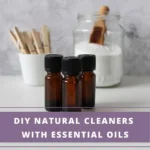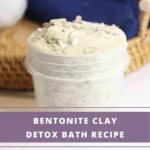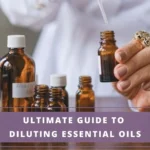As an Amazon Associate I earn from qualifying purchases. See Full Disclosure Here
Incorporating hydrosols into your lifestyle is a gentle and inexpensive way to ramp up your aromatherapy experience. Mild and nontoxic, hydrosols offer a long list of benefits without any nasty side effects.
This ultimate guide to hydrosols covers all of these topics:
What are hydrosols?
How are hydrosols made?
Difference between hydrosols and essential oils
What are hydrosols used for?
Benefits of hydrosols
How & where to buy hydrosols
How to store hydrosols
Plant Therapy hydrosols
FAQs on hydrosols

What are Hydrosols?
Hydrosols are essentially floral waters. They are the aromatic byproduct of the essential oil steam distillation process and are made up entirely of cellular botanical water.
The steam distillation process produces two end products – essential oil and hydrosol. The essential oil contains the oil-soluble components of the plant while the hydrosol contains the water-soluble components of the plant. Both products share many of the same properties. Both even have similar aromas. However, they have distinctly different potencies. Essential oils are highly concentrated while hydrosols are mostly water with very tiny amounts of essential oil.
Gentle, non-toxic, and delicately scented, hydrosols are very versatile and can be used in a variety of ways. They are widely used in a variety of bath, body care, and aromatherapy formulations as well as perfumes.
How Hydrosols Are Made
Hydrosols are created during the same process used to produce essential oils.
To extract essential oils via steam distillation, various botanicals are placed along with water in specially designed steam distill equipment and heated under pressure.
The exact plant part that is used depends on the plant and the type of essential oil to be extracted. Some essential oils, such as lavender, rose, and jasmine, are extracted from the flowers of the plant. Essential oils of cinnamon, rosemary, and eucalyptus are extracted from the leaves or bark of the plant. Citrus oils such as grapefruit, bergamot, and lemon, are extracted from the rind of the fruit.
When the plant parts and water are heated under pressure, two things happen. The pressure extracts the oils from the plant parts and the heat converts the water to steam.
The volatile molecules that evaporate more easily are carried upwards by the steam. This steam and molecule mixture is transported over to a specially designed condensing chamber. Here, steam gets converted back into water. When this happens, the oil floats to the top. This oil is the essential oil that has just been extracted and the water that’s left behind is hydrosol.
This water, or hydrosol, is not just plain water. It contains the water-soluble components of the plant’s volatile ingredients. Some hydrosols may contain trace amounts of essential oil residue in them, which is absolutely okay.
So are hydrosols and essential oils the same thing? No, there is a difference between the two.
Difference Between Hydrosols & Essential Oils
We know that essential oils and hydrosols are derivatives of the same extraction process. The end product of the process results in a hydrosol and essential oil. Both of these contain the same therapeutic properties as the plant that was used as the base material.
However, although they both have the same properties, there is an inherent difference between the two products.
The essential oil obtained from the steam distillation is 100% pure oil while the hydrosol is made up mostly of water. Some hydrosols may contain trace amounts of essential oil. Both take on the color of the herb or plant that was used.
Another big difference between hydrosols and essential oils is that hydrosols can be diluted in water. This makes it easier to add hydrosols to any water-based skin care product or in the bath.
What Are Hydrosols Used For?
Their subtle aroma and gentle properties give hydrosols a lot of versatility. They can be used in a variety of ways.
Hydrosols are milder and gentler on the skin. You can use a hydrosol directly on your skin without any risk of adverse reaction or irritation. This is unlike essential oils, which must always be diluted with a carrier oil before applying to the skin.
Hydrosols are a popular addition to a variety of skincare products including creams, skin cleansers, facial masks, facial toners, and lotions.
Their enhanced solubility also makes hydrosols the preferred alternative for homemade aromatic air freshener sprays.
Hydrosols can also be used as a mild, natural fragrance when you are looking for something that is a little cheaper than essential oils
Because hydrosols are also less likely to stain fabric, they can also safely be used to make fabric sprays to scent your linen.
Check out these 21 amazing ways to use hydrosols for bath, body, and home.
Benefits Of Hydrosols
Every hydrosol has its own distinctive properties and characteristics that are different from those of other hydrosols. Every hydrosol also has its own distinctive aroma that’s different from others.
Each hydrosol offers similar benefits as its counterpart essential oil but on a more diluted scale. Here’s a look at some of the more popular hydrosols and the benefits they offer:
Lavender hydrosol – Relaxing, calming, soothing aroma
Rose hydrosol – Great as a mood booster, aphrodisiac, skin astringent, and natural floral perfume
Tea Tree Hydrosol– Very effective for blemish-free skin and as a decongestant
Roman Chamomile Hydrosol – Soothes irritated skin, acts as a toner for oily skin and supports better sleep
Helichrysum Hydrosol– Soothes sore muscles and skin irritation, supports natural healing of scars and bruises
What To Look For When Purchasing Hydrosols
Not all hydrosols are created equal or of high quality. Many lesser-known manufacturers add water to a few drops of essential oil and market these as hydrosols. These are not genuine hydrosols. Not only will these not do you any good but they could even be harmful. Adding water to essential oils shortens the shelf life of the oil.
The key to buying pure high-quality hydrosols is to buy them from a known, reputed brand. Plant Therapy is my go-to brand for buying hydrosol.
Always check that ‘hydrosol’ or ‘hydrolat’ is listed as the primary ingredient and not far down the list of ingredients. You also want to make sure that the product has no added fragrance, perfume, colors, or dyes. It should absolutely no additives.
Some hydrosols that are specially formulated for specific purposes may list other ingredients and that’s okay. For example, a hydrosol to be used as a Face Mist may have Aloe Vera or Calendula extract, both of which are good for the skin.
How To Store Hydrosols Correctly
The right way to store hydrosols is in a cool dark environment with consistent temperature like the fridge.
Good quality hydrosols have high water content and they are preservative-free. Both of these factors increase the risk of bacterial contamination and shorten the life span of the hydrosol.
Storing hydrosols in the fridge preserves the integrity of the components. The hydrosol will last longer with all of its properties and benefits intact. As an added bonus, spritzing the cool hydrosol on your face and body can feel very refreshing.
Do not store hydrosols in the freezer. The sub-zero temperature in the freezer can damage the components of the hydrosol.
Hydrosol FAQs
 How long do hydrosols last?
How long do hydrosols last?
The shelf life of each hydrosol is different. It depends on the botanicals of that particular hydrosol, its pH level, distillation conditions, storage conditions, and how it is handled.
Which hydrosol is best for skin?
Lavender Hydrosol as astringent and purifying properties and is suitable for all skin types.
Rose Hydrosol is better suited for combination and oily skin. It is also good for sensitive skin.
Witch hazel helps to regulate oily skin and tighten pores
Which hydrosol is good for hair?
Rose, Rosemary and Witch Hazel Hydrosols are best for oily hair.
Lavender and Neroli Hydrosols are good for dry hair.
Witch hazel is good for oily hair.
Can I use hydrosol in a diffuser?
You can use hydrosol in all types of diffusers except for nebulizing diffusers. These diffusers are designed to be used with concentrated essential oils. Putting hydrosol into a nebulizing diffuser will damage the mechanism.
Hydrosols are a great option to add to your diffuser if you want to infuse your room with an aroma that’s more subtle than essential oils. When using hydrosols in a diffuser you don’t need to add water to the tank as the hydrosol itself is made up mainly of water.
Can I freeze hydrosols?
No, you should never freeze hydrosols. Freezing damages the components and renders the hydrosol unusable.
Can you heat hydrosols?
Hydrosols are sensitive to high heat. If you do need to heat it for a recipe, make sure to heat it gently. Do not overheat.
Want to learn more about hydrosols?
These are excellent and reliable books on the topic.
Hydrosols: The Next Aromatherapy
Essential Waters: Hydrosols, Hydrolats & Aromatic Waters
Hydrosols: Aromatherapy’s Emerging Star: Includes recipes for health, home, and beauty

Disclaimer: This information is not intended to serve as medical advice. Please consult your doctor before using any natural medication or if you experience any unusual symptoms. See Full Disclaimer here.









